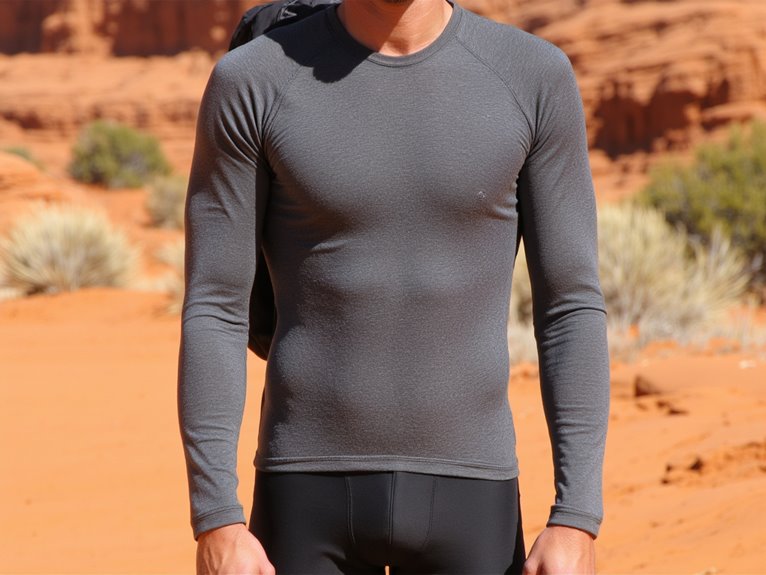Wearing Merino Wool Base Layers in Warm Weather: When and Why
You can wear merino wool base layers in warm weather because their crimped fiber structure creates superior cooling through moisture evaporation and breathability. The fabric absorbs up to 30% of its weight in moisture vapor without feeling wet, while maintaining your skin’s microclimate between 32-35°C regardless of external heat. Ultra-fine fibers measuring 17-24 microns provide comfort without itchiness, and natural antimicrobial properties prevent odor buildup during extended wear in hot conditions, making them ideal for various summer activities where additional benefits become apparent.
We are supported by our audience. When you purchase through links on our site, we may earn an affiliate commission, at no extra cost for you. Learn more. Last update on 16th December 2025 / Images from Amazon Product Advertising API.
Notable Insights
- Merino wool’s crimped fiber structure creates air pockets and regulates skin temperature between 32-35°C regardless of external conditions.
- The fabric absorbs up to 35% of its weight in moisture without feeling wet, exceeding polyester’s moisture-buffering capacity by 96%.
- Natural antimicrobial properties from lanolin prevent odor-causing bacteria, maintaining freshness for up to seven days without washing.
- Ultra-fine fibers measuring 17-24 microns provide silky comfort without itchiness, making extended wear comfortable against skin.
- Ideal for high-intensity activities like running, cycling, and hiking where superior moisture management and temperature regulation are essential.
Understanding Merino Wool’s Natural Cooling Properties
While many assume wool is only suitable for cold weather, merino wool‘s sophisticated fiber structure actually makes it an exceptional choice for warm-weather base layers.
The crimped fibers create microscopic air pockets that facilitate microclimate regulation next to your skin. Unlike synthetics, merino wool absorbs up to 30% of its weight in moisture vapor without feeling wet. This enables evaporation cooling directly on the garment rather than your skin.
Merino wool’s crimped structure creates air pockets for superior moisture absorption and evaporative cooling without the wet sensation of synthetics.
The fiber’s unique structure features a hydrophobic exterior and hydrophilic interior. This design transports moisture primarily in vapor form, not liquid sweat.
Merino wool’s moisture-buffering capacity exceeds polyester by 96% and cotton by 45%. This vapor-phase breathability prevents sweat accumulation while maintaining thermal equilibrium during both activity and rest phases. The neutral charge of merino wool fibers also prevents static buildup that can cause garments to cling uncomfortably to skin during warm weather activities.
This natural performance advantage allows athletes to remain focused on their challenges during high-output activities without the distraction of moisture management issues.
Moisture-Wicking Performance in Hot Climates
When temperatures soar and humidity climbs, merino wool’s moisture-wicking performance becomes its most valuable asset for maintaining comfort. The fibers pull sweat away from your skin and transport it to the fabric surface for immediate evaporation. This creates a natural cooling effect that intensifies as your body generates more heat.
Unlike synthetics that trap moisture and cause heat retention, merino wool’s breathable structure allows continuous airflow around your skin.
The wool’s superior moisture management prevents the clammy sensation common with cotton or polyester base layers. While cotton holds sweat against your body and synthetic fabrics often feel sticky, merino wool maintains a dry micro-climate. Just as breathable materials enhance comfort in hiking footwear by maintaining dryness during wet conditions, merino wool creates an optimal environment for your skin.
This performance advantage becomes critical during extended activity in hot climates, where effective moisture transfer determines your comfort level throughout the day. Merino wool blends provide superior cooling through moisture-wicking technology, reducing foot temperature by 8-12 degrees compared to standard materials.
Temperature Adaptation and Heat Regulation
Merino wool’s exceptional moisture management works in tandem with its sophisticated temperature regulation system to create optimal comfort across varying heat conditions.
The fiber’s unique ability to generate heat through moisture sorption while simultaneously enabling evaporative cooling creates dynamic thermal comfort that adapts to your body’s needs.
In warm weather, three key mechanisms maintain ideal skin temperature:
- Vapor wicking – Moves sweat away from skin to evaporation zones
- Surface cooling – Evaporation removes latent heat, lowering skin temperature
- Air circulation – Crimped fibers create breathable microclimates
This temperature regulation system stabilizes your skin’s microclimate between 32-35°C regardless of ambient conditions.
Unlike synthetic materials that trap heat, merino wool‘s hydrogen-bonded structure enables controlled heat transfer, preventing overheating while maintaining consistent thermal comfort throughout activity levels.
The Iguana Merino Wool Base Layer demonstrates this versatility, offering superior moisture-wicking capabilities that maintain breathability even during extended wear in varying temperature conditions.
Odor Control for Extended Wear in Heat
You’ll find that merino wool‘s natural lanolin content creates an antibacterial barrier that actively inhibits odor-causing bacteria growth on your base layers.
This antimicrobial property works continuously during extended wear in hot conditions, preventing the bacterial proliferation that typically occurs when sweat meets synthetic fabrics.
Your merino base layers can maintain freshness for multiple days without washing, making them ideal for backpacking trips, travel, or any situation where laundry access is limited.
These same antimicrobial properties that make merino wool base layers excel in warm weather also extend to hiking socks, where they reduce odor and allow for extended wear duration on multi-day outdoor adventures.
Natural Antibacterial Properties
One of the most remarkable features of merino wool lies in its natural ability to control odors through inherent antibacterial properties that make it exceptionally well-suited for extended wear in warm conditions.
The antibacterial mechanism operates through lanolin, a waxy substance naturally present in merino fibers. Lanolin benefits include creating an inhospitable environment for odor-causing bacteria while contributing to self-cleaning effects when exposed to moisture. However, wool doesn’t directly kill bacteria or release antibacterial agents.
Instead, merino’s unique fiber structure prevents bacterial proliferation through three key processes:
- Trapping odor molecules within fibers before bacteria can break them down
- Managing moisture levels that reduce bacterial growth environments
- Binding odor compounds reversibly until washing releases them
This system maintains garment freshness during multi-day use in warm weather without frequent laundering. The natural odor resistance allows for multi-day wear without washing, making merino base layers practical for extended outdoor activities even in warmer conditions.
Multi-Day Freshness Benefits
When extended outdoor adventures demand continuous wear in warm conditions, the superior odor-resistance of merino wool base layers becomes immediately apparent.
You’ll maintain freshness for up to seven days without washing, even during high-perspiration activities. The fiber’s natural lanolin content inhibits bacterial growth that causes odor accumulation.
Merino wool’s moisture-wicking structure reduces dampness against your skin, creating an environment where odor-causing microbes can’t thrive.
This performance dramatically outpaces synthetic alternatives and cotton blends. Your base layer maintains structural integrity and odor-controlling properties throughout repeated wear cycles.
This extended freshness supports sustainable fashion principles by reducing washing frequency and garment turnover.
You’ll experience reduced logistical burden during multi-day trips, eliminating the need for frequent clothing changes while maintaining comfort and hygiene standards.
The temperature regulation capabilities of merino wool base layers also contribute to this odor control by managing your body heat effectively in varying conditions from 10°F to 64°F.
Comfort and Skin-Friendly Benefits
When you wear merino wool base layers in warm weather, you’ll experience exceptional skin comfort thanks to the ultra-fine fibers that measure less than 24 microns in diameter. This refined fiber structure eliminates the scratchy, irritating sensation associated with traditional wool, allowing direct skin contact without discomfort even during extended wear.
Whether you’re caught in unexpected rain or working up a sweat, the wool’s moisture-wicking properties keep the fabric feeling soft and non-clingy against your skin, maintaining comfort levels that synthetic materials simply can’t match.
Soft Against Skin
Merino wool’s extraordinary softness transforms the base layer experience through its ultra-fine fiber diameter, which measures just 18-24 microns compared to traditional wool’s coarser 25-40 micron range.
This micro-fine structure creates a soft texture that eliminates the scratchy sensation you’d experience with regular wool. The natural crimp in each fiber provides flexibility and a gentle feel that conforms to your skin contours without stiffness.
Three key factors contribute to merino wool’s superior comfort:
- Ultra-fine fiber diameter reduces surface friction against skin
- Natural crimp structure provides flexibility and cushioning
- Smooth fiber surface creates an almost silky tactile experience
You’ll notice the difference immediately when wearing merino base layers, as the fibers bend rather than poke your skin, maintaining comfort during extended wear periods.
No Itch Factor
Traditional wool’s reputation for itchiness fades away completely with merino wool base layers, thanks to their revolutionary fiber structure that measures just 17-24 microns in diameter.
This ultra-fine measurement—one-tenth the width of human hair—creates fibers that bend easily against your skin rather than poking and irritating it.
Your body benefits from merino’s natural hypoallergenic properties, making it essential for effective allergy management techniques. The smooth fiber surface reduces friction and micro-abrasions that cause redness on sensitive skin.
You’ll experience superior moisture absorption up to 35% of the fabric’s weight, preventing the clammy irritation of wet fabric against skin.
These characteristics form the foundation of proven itch prevention strategies. Merino’s protein structure remains biocompatible with human skin while lacking harsh chemicals found in synthetic alternatives.
Wet Weather Comfort
Beyond its skin-friendly properties on dry days, merino wool’s true performance advantage emerges when conditions turn wet and humid.
You’ll experience superior moisture management as the fiber absorbs up to 35% of its weight before feeling damp. This prevents skin irritation that typically occurs when synthetic fabrics trap moisture against your body.
Merino wool’s wet weather comfort stems from three key mechanisms:
- Moisture vapor absorption – Pulls sweat into the fiber structure rather than leaving it on your skin
- Thermal regulation – Maintains insulation properties even when wet, preventing rapid heat loss
- Breathable structure – Promotes air circulation to prevent overheating in humid conditions
The fine fiber diameter eliminates chafing against wet skin while natural elasticity prevents pressure spots during extended wear in damp conditions.
Frequently Asked Questions
What Weight Merino Wool Is Best for Temperatures Above 80°F?
You’ll want ultralight to lightweight options weighing 105-170 g/m² for temperatures above 80°F. These weights provide ideal temperature regulation and breathability while preventing overheating during warm weather activities.
How Much Should I Expect to Pay for Quality Merino Base Layers?
You’ll spend $70-150 for quality merino base layers, with price comparison showing lightweight options cost less than heavy-weight versions. Quality indicators include fiber fineness, brand reputation, and construction features that justify higher prices.
Do Merino Wool Base Layers Shrink When Exposed to High Heat?
Yes, merino wool base layers definitely shrink when exposed to high heat effects. Key shrinkage factors include temperatures above 86°F, tumble drying, and agitation – you’ll see 10-30% size reduction.
On a final note
You shouldn’t dismiss merino wool base layers when temperatures rise. The fiber’s natural moisture-wicking properties and temperature regulation make it effective in warm conditions. You’ll benefit from its odor resistance during extended activities and multi-day adventures. Choose lightweight 150-200 GSM merino for hot weather applications. You’ll find it particularly valuable for hiking, travel, and situations where you can’t change clothes frequently. It’s a versatile investment that performs year-round.

